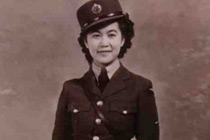
Jean Lee was born and raised in Cranbrook, British Columbia and had the distinction of being the first and only Chinese Canadian female in the RCAF’s Women’s Division. Her life is best described in this article, written by Jim Cameron and published in the Cranbrook Daily Townsman Newspaper (November 7, 2014).
***
Born in Cranbrook, on July 26, 1924, Jean Lee enlisted in the Royal Canadian Air Force in 1942, the first and only Chinese-Canadian to be accepted into the RCAF’s Women’s Division during the war, a division of over 17,000 women.
The Lee family’s Cranbrook roots date back to the very early 1900s, when her grandfather, John Lee, came here from China. John Lee, as with most of the resident Chinese, made his home in what was then Chinatown, the area between 6th and 7th Avenue and Van Horne and 2nd Street.
He ran a general store for many years until his death on May 2, 1925, at the age of 58. His short obituary in the Herald newspaper — and it’s worth noting that a Chinese obituary in any Canadian newspaper was a rarity at the time — states that the last rites for Lee John, “… a Chinese celebrity … are expected to be conducted with all the éclat [showy display] that is accorded to prominent Celestials [Chinese]. He was a well-known business man of this city.”
The notice of his death, no matter how sardonic, indicates the social position to which he had risen in the general community. John Lee’s affairs were assumed by his son Look Lee (also known as Lee Chow Man), who himself arrived here with his father at the age of 12. He attended public school for a short while, returned to China for a few years and returned again to Cranbrook to manage Sam Yick’s store on 7th Avenue for many years thereafter. His death, at age 49, in March, 1940, was marked by a longer and respectful obituary. Under the headline “Death Takes a Prominent Chinese Here,” it remarks upon the respect Lee Look garnered in the community and noted that he owned a great deal of property in both Cranbrook and Kimberley. He left behind a wife, six sons and three daughters, one of whom was Jean Lee.
Tracing early records of Canadian-Chinese is challenging, due in part to the Chinese habit of placing the family surname before their given names, often causing confusion on official documents. The fact that some Chinese used an adopted English name while others of the same family did not also confounds the issue.
Further, many, if not most, local Chinese births, marriages and deaths of the time were rarely officially recorded. Thus, little is presently known of Jean Lee and her life before and after her military service. She enlisted in Cranbrook in 1942, the same year that the Canadian military began accepting volunteers of Chinese descent. In an article in a 1943 issue of the Halifax Daily Star, she states that a Mobile Recruiting Unit visited Cranbrook and, out of curiosity, she asked a number of questions.
Before she knew it she had joined up, a move she did not regret. She took basic training in Toronto and served until the end of the war, mainly at the Eastern Air Command RCAF depot in Rockcliffe, Ontario. Along the way she was invited to meet Canadian Prime Minister Mackenzie King in 1943, and also, in June of the same year, was posted as a member of the honour guard of Madame Chiang Kai-Shek (wife of Chinese President Chiang Kai-Shek) in Ottawa. During the inspection, China’s first lady paused to have a lengthy chat with Jean Lee, a rare honour indeed.
Her brother, Wilson, born Feb. 19, 1919, moved to Kimberley before the war to run the Ritz Café for his father. It is probable that Jean joined him at some point. Wilson began training as a pilot at local flying schools in the late 1930s, becoming a licensed aviator. He, too, garnered respect within the community as shown by an invitation as guest speaker to both the Cranbrook and Kimberley Rotary clubs in 1939, at which time he gave a talk on China’s attempts to free itself from the Japanese yoke of oppression.
Wilson enlisted in the RCAF, achieving the rank of Pilot Officer and spending the duration of the war training pilots at Fort McLeod, Alberta, and Dauphin, Manitoba. Following the war he returned home before taking up residence in Lethbridge. His son, Arthur Lee (Jean’s nephew), born in 1947, was elected to the Canadian House of Commons as a Liberal candidate in 1974, while living in B.C., and served for five years. From 1984 to 1987, he served as the Liberal Party leader of B.C., the first Chinese-Canadian leader of a party in Canada.
Still, that is not quite all of the “firsts” for the Lee family. Until 1947, neither Chinese immigrants nor their children were allowed full rights as Canadian citizens. Upon signing the United Nations’ Charter of Human Rights at the conclusion of WWII, the Canada Government was required to repeal the Chinese Exclusion Act. On Feb. 19, 1947, Jean Lee joined two other women and four men, all veterans of the Second World War, in the Commodore Ballroom in Vancouver, to become the first ever Chinese-Canadians to receive their Canadian Citizenship Certificates.
There is obviously more to be learned of the life of Jean Suey Zee Lee and her family. It is hoped that it will come to light in the future.
With thanks to Dave Humphrey, the Cranbrook Archives and Sioux Browning.”